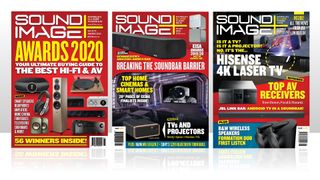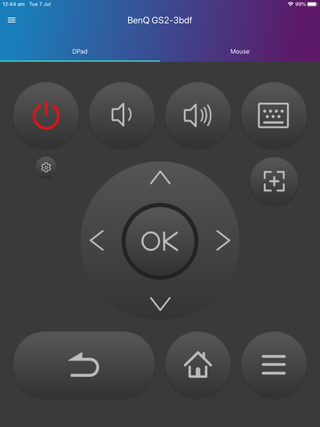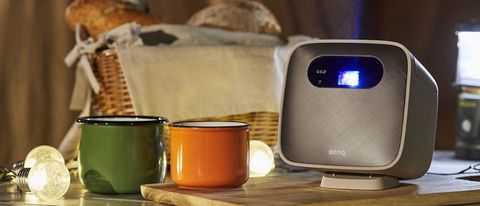
This review originally appeared in Sound+Image magazine, one of What Hi-Fi?’s Australian sister publications. Click here for more information on Sound+Image, including details on how you can subscribe.
A couple of years ago we spent some time with the BenQ GS1 projector. It was a nifty little Wi-Fi and Bluetooth-enabled portable unit with built-in battery. It was very cool, great for a few hours of group entertainment wherever you may be — camping, perhaps, projecting onto the tent. Now BenQ has the GS2 available, and we have to say it’s even cooler than the original.
Build
The GS1 was like a traditional projector in miniature, flat in shape and finished in white, although it did come with a bright orange protective skin. The BenQ GS2 is very different.
It’s near cubical, though not quite, as you can see from the pictures. It’s coloured a gentle tan. Apparently impact protection is built in, since the box proclaims that the unit can cope with a half-metre drop (we didn’t try). And it’s also IPX2-rated — that’s splash-proof, but we wouldn’t suggest leaving it out in a rain storm.
The GS2 can tilt back on its base to guide the direction of the picture, and there’s auto keystone correction to fix the resulting wonky frame shape. A threaded hole, compatible with camera tripods is in the middle of that. (Although the hole proved too shallow for our Manfrotto tripod. We had to use some cardboard as a spacer.)

Features
On the top are the control buttons. All are just marks etched into the material. You press them and the surface flexes slightly, actuating the relevant control. On one side near the top is a panel that feels like it’s made of a harder-than-usual silicone. Pulling it out exposes the HDMI input, a USB Type-A slot, a USB Type-C socket and a 3.5mm analogue audio output for plugging in a speaker. But the GS2 does have two speakers built in, each driven by a two-watt amplifier.
Also in that section is a deep bay with a USB socket inside. You plug the included Wi-Fi dongle into that, allowing it to disappear completely from sight. The dongle supports dual-band Wi-Fi standards up to 802.11ac. The projector also supports Bluetooth for connecting speakers and headphones. We’re guessing that the Bluetooth support is also within the dongle.
Power is supplied by an external power pack. The power connection is similar in style to the magnetic ones used on certain Mac computers. Built-in is a battery to allow portable operation. This is rated at providing up to three hours of operation.
The projection engine uses DLP technology. The digital micromirror device is a tiny 0.3-inch model offering 720p resolution, which is to say 1280 pixels across by 720 vertically. The projection engine supports incoming signals of up to 1080p.
That’s the same resolution as the GS1, but the brightness has been bumped up from 300 lumens to 500 lumens, presumably because of a change in the lamp model — an Osram Q8A LED light source is employed, which gives way more lamp life than is ever likely to be used in a projector of this kind: 20,000 hours in normal (that is, high brightness) mode, and 30,000 in ‘Eco’ mode.
There’s no optical zoom function in the projector. You move the unit to align the image with your projection surface. BenQ clearly considers 100-inch (2.54-metre) screens about the maximum size to be usefully employed — that’s the maximum size in the table in the manual. To fill such a screen the projector must be 2.88m away.
Given Wi-Fi, the BenQ GS2 is, of course, a smart projector. It runs on Android, and since it runs on Android, there are several apps that run on it. You can cast screens to it from your smart devices, including Apple devices using AirPlay. It supports Miracast.
It can connect to your network, and that’s obviously the way that you’ll use it at home. But it can also act as a Wi-Fi hotspot, so if you’re away from a network you can still connect your phone to it and mirror content to the projector.
There were only a few apps installed on the BenQ GS2 by default: Netflix, Prime Video, YouTube, iQIYO — a Chinese-based movie and video streaming service — and Aptoide. That last is a store for additional apps, of which there are a seemingly limitless number. We easily found ABC iView there, but couldn’t find SBS On Demand.
The projector comes with a canvas carry bag, finished in darker brown hues. This has a definite retro feel to it. It is also supplied with a slim aluminium remote control. The projector can also be controlled using the BenQ Smart Control app on Android and iOS.

Picture
When we pulled the BenQ GS2 from its packaging and placed it on a surface we judged suitably located for our projection screen, we puzzled over how to adjust the focus. There were no knobs, nor any buttons labelled ‘Focus’. So we just turned on the projector and one of the first things it did was flash up a blue test pattern and adjust its own focus. Clever.
The projector also has auto keystone, but to our eye it left the uprights slightly splayed out towards the top. We have an abiding hatred of keystone correction anyway, especially when you’re using a 720p display and thus don’t want to waste any pixels at all. So we just switched it off and made sure the projector was properly aligned.
If you do as we did, do remember to go into the manual keystone adjustment afterwards and adjust it back to zero. We found that whatever value the auto keystone adjustment had determined remained in place when auto was switched off.
You can, of course, switch off auto focus as well and use the remote (or remote app) to adjust the focus manually.
Now, as you might expect, the picture had a fairly soft focus. Oh, the optics were fine and we found that the autofocus did an optimum job. When inspecting the screen closely we could see that the individual pixels were properly focused, although there was no screen-door effect visible from even a couple of metres away. (There was also no rainbow effect at all.)
But with eyes accustomed to UltraHD displays, 720p inevitably feels soft. (Why didn’t BenQ use a 1080p DMD? The small form-factor of the projector requires a physically small DMD. There isn’t a 1080p one small enough.)
The colours were good, if not as rich as some. Black levels were actually quite good, with the black top and bottom bars on 2.35:1 movies barely distinguishable from the surrounding screen. Brightness uniformity was good, with the dullest part of the picture at 80% of the brightness of the brightest part.
When running on battery the picture brightness roughly halved. When plugged in, the image was clearly visible under bright room lights. In a darkened room it seemed quite bright. The battery-operated brightness was just a little too dark to be entirely enjoyable, but of course we understand that there’s no point having a bright picture if the battery is going to run out halfway through a regular movie.
It was clear that all content, whatever the frame rate, was converted to 720p/60 for display. That resulted in marked judder with all 50Hz material, and some visible judder with 24p video. With interlaced 50Hz material, all progressive-scan conversion was based on the assumption that the content was video-sourced, although the resulting deinterlacing artefacts were softened by the lower display resolution.
Of course, if you’re after high-end home theatre performance, you’ll be looking for a proper 1080p or 4K home theatre projector. The fun of the BenQ GS2 is its portability and its networking capabilities.
Smart stuff
When you fire up the projector you are presented with a home screen that sets out all its capabilities. You can arrow around to choose from the inputs, the installed apps and a row of settings. If you use the Smart Control app, you can change to the mouse-pad tab and then slide an arrow around on the screen.
On the home screen, the top line invites you to connect to the BenQ GS2 with your iPhone/iPad/Mac, or your Android device, or your Windows PC. Those invitations are a little misleading because they actually give the wrong name for the projector.
For example, the iOS/macOS section tells you that the projector is ‘Ready to AirPlay!’ And it tells you what device to connect to for AirPlay. Except that the name is wrong. It displays the name of the Wi-Fi access point. What you actually need to look for on your device is the name of the projector. AirPlay did most certainly work when we selected ‘BenQ GS2-3bdf’, the real name of the review projector.

The screen mirroring with an iPhone, an iPad and a Mac was fast and reliable. With the Mac, for example, when we waved the mouse cursor over the secondary desktop the Mac displayed on the BenQ GS2’s display, there was the barest minimum of lag. We wouldn’t play reflex-based games, but for regular computing it was fine.
However, the BenQ GS2 seemed to be fussy about the devices from which it would accept connections. It worked with our Samsung Android tablet, but it would not work with our Huawei P30 Pro phone. And it would not work with either of our two Windows computers.
y ‘would not work’ we mean that those devices simply could not see the BenQ projector, so could not connect to it. (Both the phone and those Windows computers worked properly with our smart TV.) It did work with our old Google Pixel 2 phone. That phone does not support Miracast, relying on Chromecast instead.
We ran the Smart Control app on the Huawei phone and it controlled the projector perfectly well. Why it couldn’t see the projector as a wireless display? Who knows. The joys of Wi-Fi.
All the other smart stuff worked well. We plugged a keyboard and trackpad combination into the USB socket and were able to use the projector as a kind of mini-computer. There are a few web browsers available in Aptoide store.

Final verdict
Look, if you’re after a great home theatre experience on a big screen, then you’ll be looking for a dedicated home theatre projector. BenQ certainly has several fine models in the genre. What the BenQ GS2 offers is a fun, versatile, smart display experience in a portable form. Check it out.
